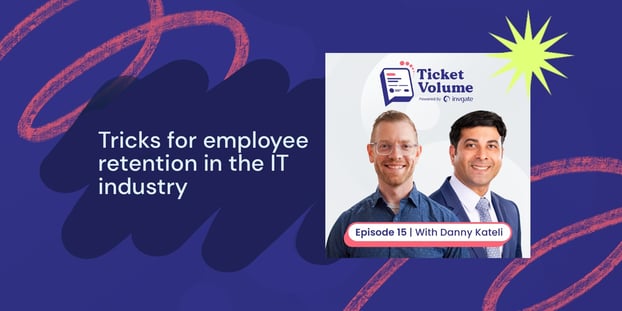The IT industry is among the most competitive ones in the world. That is why IT employee retention is a big problem. The average employee turnover rate in this sector is around 20%. In any given year, one-fifth of the workforce changes jobs.
There's a high turnover rate and an even higher percentage of employees who are unhappy with their jobs. Another reason is that people don't see their work as fulfilling or challenging enough to be worth staying at their company for an extended period.
Companies need to constantly work on retaining their employees by providing them with a great work environment, competitive salary and benefits, and a strong leadership team. The great resignation as a result of the pandemic also affected employee retention efforts across all areas.
On that note, our podcast host Matt Beran brought Danish (Danny) Kateli along to be his guest on Ticket Volume’s 15th episode. He is the Manager of IT Operations at Midrex, where he's in charge of network infrastructure, data center maintenance, IT security, and the service Desk.
Right now, his company is focused on retention, so much so that they have established a retention project. Hence, he talked about his strategies to keep employees happy and engaged.
Keep reading to find out!
Why is employee retention so necessary?
Employee retention is a crucial factor in any company's success. It is one of the most important aspects of HR, and it’s a top priority for any business. The main goal of employee retention is to keep your talent happy.
It is a significant issue in our industry. The high cost of replacing an employee can be staggering — and if you’re a small business, you may not have the budget to hire and train someone new on short notice. To give you an idea, the turnover rate for IT professionals is as high as 25%, which costs the US economy $350 billion annually in lost productivity.
There are several reasons why employee retention is essential. For example, it costs less to retain an employee than to hire and train a new one. Retained employees know the company better, leading to higher productivity and lower turnover rates.
Companies can use various strategies for retaining employees, such as giving them more autonomy or providing better benefits packages.
|
|
"We have great chemistry within the team. So retaining our family members within the IT Operations team is really important. We have had challenges in the past with retention, and a team can only sustain so long for picking up someone else's work. You've gotta hire another person and quickly before other people get burnt out." Danny Kateli |
Why is it hard to retain employees in the IT industry?
The IT industry has always been a challenging one to work in. There is a lot of competition, and the demand for skillsets is constantly changing, which makes it hard for employees to stay on top of their game. The pandemic has further exacerbated this problem.
More specifically, some other reasons why it is hard to retain current employees and attract new ones in the IT industry are:
- The industry is constantly changing and evolving, so employees are pressured to keep up with the latest trends.
- There are a lot of startups and new companies coming up every day, and people want the chance to be a part of something new instead of working at an established company where they might be doing the same thing over and over again.
- Talking about startups. This is especially true for startups who may have been able to offer a competitive salary before the pandemic, but can no longer do so post-pandemic due to budget restrictions.
- The scarcity of experienced talent makes it difficult for companies to keep up with market demands and innovate.
- The economic downturn has also meant that many tech companies have had their budgets slashed or have had to lay off employees due to financial constraints.
- Employees often feel that they're not being challenged enough or given enough responsibility. This leads them to feel unappreciated and undervalued by their employers.
- Employees may be unhappy with the company culture, feeling that they don't fit in or have any sense of belonging at work.
- There are so many paths to take, and people often don't know what they want to do for their careers until later in life.
How to retain IT employee
Let’s dissect Danny’s takes on how his team leader experience has helped increase employee retention.
|
|
"I consider myself like the oil, and my teammates are like the big wheels that are churning and burning, either tickets or projects." Danny Kateli |
1. Establish a retention project
Kateli is a member of a team dedicated to employee retention, which strategies are inspired by the HDI conferences and previous studies about it. They are also drawing inspiration from what other companies are doing. For instance, his team is considering bringing on a new hire, orienting them, getting them acclimated, and making a proper offer. That is definitely a different approach from what they are used to, but that could lead to more engaged employees.
2. Let them grow
Millennial employees are interested in growth and development. That is why you should share your organization's opportunities for professional growth and learning with its employees, so they know what they need to do to advance.
Assign them projects that let them see how their skills translate into real-world applications or situations. Millennials love learning about new technologies because it gives them an opportunity to expand their knowledge base and become more valuable within your company's workforce as well as in general society. They also enjoy having a chance to stretch their muscles by trying something new for the first time — such as leading meetings or managing projects — which lets them gain experience outside their comfort zone.
3. Embrace turnover
When someone leaves the company, thank them for their contributions and wish them well. Have a farewell party to celebrate the time they spent with you. In the meantime, redesign your business model to reduce turnover and ensure that you can continue to provide the same level of support to clients.
During the recruiting process, outline what candidates could expect from the company. If it is the case, be candid about the fact that you aren’t offering the highest salary in the industry, but point out that your organization’s culture was a major component of the brand and that employees could enjoy perks and growth opportunities.
|
|
"We recently were required to read this book called 'The Ideal Team Player,' which where it talks about [being] humble, hungry, smart. It's written by Patrick Lencioni, same author as or from the book 'Five Dysfunctions of a Team." And so I'm all full on board. I'm very passionate about humble, hungry, smart, and so we are really gearing towards a Midrex where we are recruiting humble, hungry, smart people." Danny Kateli |
4. Give them autonomy
As a leader, you should be able to rely on your team even when you are not present. A study by the University of Washington Foster School of Business examined the connection between an individual's orientation toward autonomy and the level of support for autonomy on their work team. They found that the outcome is a level of psychological empowerment that predicts whether a person will seek a new job.
This makes sense because if people feel like they have more control over their work and life, they are more likely to continue working for you.
So, give them ownership over projects or initiatives. Give them a chance to show off their talents and make decisions without having to wait for approval from someone else first. This allows them to feel like they've made something meaningful happen for themselves or for others in addition to getting paid for it.
|
|
"I always tell my teammates to be amped up. I want them to be autonomous in making decisions without me. So if I get hit by a bread truck or a beer truck, I want them to be able to make decisions and not be, 'Oh, Danny's not here.'" Danny Kateli |
5. Be transparent about goals and expectations
If your team knows what they are supposed to achieve and how they will be measured, they'll feel more empowered to take control over their own work and make decisions on their own timeframes. This also helps ensure that everyone has the same goals in mind for the company going forward, which increases collaboration between departments and boosts productivity.
Also, they want to feel like they're working toward something bigger than themselves. This is why it's important that managers help them understand how their work contributes to those goals.
6. Offer flexible work arrangements
Many workers are looking for flexible schedules, so they can better balance their family life with their career aspirations. If you can offer remote work or flex-time options, it will make your employees happier because they have more control over their schedule and time management.
This may mean working from home, working shorter hours, or having different start and finish times every day. You need to make sure that your IT department has the capabilities and infrastructure in place to support this type of flexible working arrangement because it can be hard for people who aren't used to working remotely (or who have no experience with remote working) to adjust if they don't have all their tools readily available when they're at home or in another location outside the office.
7. Provide balance
Believe it or not, most people are driven by purpose, not just compensation. Your best IT talent wants to know there's more to life than work, so make sure you provide opportunities for your team members to get outside the office and enjoy themselves, like active pauses. This will help them maintain a healthy lifestyle (by helping with their mental health and avoiding burnout!) and improve productivity at work by bringing them back into the office with renewed energy each day.

Key takeaways
If you want to keep your employees happy and engaged, you must pay attention to them. You have to show that you care about their professional development and progress. Thus, it’s essential to provide them with opportunities for growth.
It is also important to create a culture where employees feel valued and appreciated by the organization. This can be achieved through various ways such as providing recognition, rewards for great work, and flexibility in work schedules.
Remember, IT employees are unique in that they're highly specialized and have a lot of options when it comes to finding work elsewhere. If you treat your employees like interchangeable cogs in a machine, chances are they'll find a more satisfying environment elsewhere.
Let’s face it, the IT industry is in flux. New technologies are implemented, and new jobs are being created simultaneously. It's hard to retain employees. There are many reasons for this, but one is that technology changes too quickly for people to keep up with it.
Education is key to an organization’s culture, and you should strongly incorporate it into your daily practices. Hence, we recommend encouraging professional development and being eager to share the information they need to advance with your employees.
Frequently Asked Questions
What are some reasons why people don't stay with their companies?
The most common reasons for employee turnover are:
- Compensation: Compensation is one of the main reasons why employees leave their jobs. If you're not paying your employees well, they will find another job where they can get paid more. The average salary in the U.S. is $44,638 per year, but salaries vary depending on industry and location.
- Work/life balance: Employees want to work for organizations that value their employees' lives outside of work. Making sure that your company has policies in place to support work-life balance will go a long way toward keeping your employees happy and engaged.
- Career growth: Employees want to feel like they're growing personally and professionally at work. If you offer opportunities for career growth, such as training or development programs, this can be an important factor when it comes time for them to look for another job.
What are some best practices for improving employee retention?
The most effective way to improve employee retention is to focus on what makes employees want to stay with your company. You can't do much about the factors outside your control, but you can do a lot about the things that are within your control and that make a difference in how people feel about their jobs. Here are some best practices for improving employee retention:
- Make sure employees know what's expected of them.
- Offer training and career development opportunities.
- Create a positive work environment by providing stability, clear communication, and fair compensation.
- Show appreciation for employees' contributions and successes, both large and small.
- Be flexible when possible in accommodating employees' personal situations, such as family obligations or health issues that affect productivity levels.
How do you calculate employee retention?
The employee retention rate is calculated by dividing the number of employees who stayed with their company for a given time period (for example, one year) by the total number of employees at the beginning of that time period (including those who left). For example, if you have 100 employees and 90 stayed with the company for an entire year, then your employee retention rate would be 90%.
What's considered a good employee retention rate?
If it's 90% or higher, that is considered a very good retention rate.
















